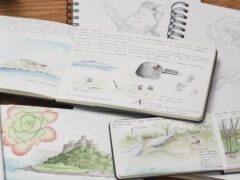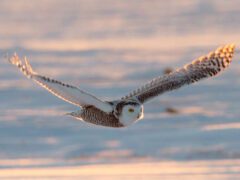Franklin's Gull Similar Species Comparison
Main SpeciesFranklin's Gull
Breeding adult
Smallish gull with a black head, a red bill, and white eye crescents. Note white spots on the tips of the primaries.
© Joe Bailey / Macaulay LibraryIndiana, April 21, 2017First winter with Laughing Gulls
Compared to the Laughing Gulls around it, note the Franklin's smaller size, smaller bill, and more black around the eye and over the crown.
© Tom Johnson / Macaulay LibraryFlorida, January 13, 2014First winter
First-winter birds have a partial grayish black hood and thick white eye crescents. The gray on the back contrasts with brownish upperwings and dark primaries. Note rather slender bill.
© Brian Sullivan / Macaulay LibraryGuanacaste, November 11, 2008Nonbreeding adult
Nonbreeding adults have a partial black hood and thick white eye crescents. The wingtips show limited black. Note slender bill and clean white collar.
© Chris Wood / Macaulay LibraryIca, November 13, 2017Breeding adult
Black-hooded gull with white eye crescents and a limited amount of black on the wingtips.
© Brian Sullivan / Macaulay LibraryTexas, April 15, 2011First winter
First-winter birds have a black tail band, but it doesn't extend across the entire tail. The primaries are mostly dark while the upperwings are brownish gray. Note smudgy grayish hood.
© Ryan Sanderson / Macaulay LibraryIndiana, October 17, 2020Breeding adult
Breeds in colonies in prairie wetlands. Fairly small gull with a slender bill. Note black head, white eye crescents, and limited black on wingtips.
© Brian Sullivan / Macaulay LibrarySouth Dakota, July 07, 2009Flock
Often forages in dense flocks.
© David Lambeth / Macaulay LibraryNorth Dakota, October 05, 2016Similar SpeciesLaughing Gull
Breeding adult
Laughing Gulls are slightly larger than Franklin's Gulls, with a longer bill that often droops at the tip, unlike Franklin's straight bill. When folded, Laughing's wingtips are almost fully black, without the large white spots of Franklin's.
© Jacques Ibarzabal / Macaulay LibraryNew Jersey, May 20, 2017Similar SpeciesLaughing Gull
Breeding adult
In flight, Laughing Gulls have extensive black on the underside of the primaries, while Franklin's has a mostly white underwing.
© Felipe Pimentel / Macaulay LibraryNew York, July 29, 2017Similar SpeciesLaughing Gull
Nonbreeding adult
Nonbreeding Laughing Gulls have less gray on the head than nonbreeding Franklin's Gulls. Note also the Laughing's larger, slightly drooping bill.
© Paul Tavares / Macaulay LibrarySouth Carolina, September 22, 2014Similar SpeciesLaughing Gull
Second winter
Note heavy bill. Second-winter Laughing Gulls have a gray wash on the breast, unlike Franklin's clean white breast. Laughing also has less gray on the head than Franklin's.
© Alix d'Entremont / Macaulay LibraryNova Scotia, November 16, 2014Similar SpeciesLaughing Gull
First winter
Note heavy bill. First-winter Laughing Gulls are grayer on the neck and breast than Franklin's Gulls, which look much cleaner white by comparison.
© James (Jim) Holmes / Macaulay LibraryYucatán, January 13, 2017Similar SpeciesLaughing Gull
First winter
First-winter Laughing Gulls have gray on the back of the neck and a complete dark tail band. Franklin's has a white collar and a tail band that doesn't reach to the outer tail feathers.
© James Rieman / Macaulay LibraryTexas, September 17, 2017Similar SpeciesLaughing Gull
Juvenile
Note heavy bill. Juvenile Laughing Gulls are more extensively brown on the head and chest than juvenile Franklin's Gulls.
© Max McCarthy / Macaulay LibraryNew Jersey, August 09, 2017Similar SpeciesBonaparte's Gull
Breeding adult
Bonaparte's Gulls are smaller and slimmer than Franklin's Gulls, with a dainty round head and a slender bill. Breeding Bonaparte's have indistinct white around the eye and red legs, unlike Franklin's bold white eye arcs and black legs.
© Yvonne Bieman / Macaulay LibraryOntario, July 23, 2017Similar SpeciesBonaparte's Gull
Nonbreeding adult
Note small, slender shape and light-gray back. Nonbreeding Bonaparte's has a neat black spot by the ear, instead of the partial gray hood that wraps over the head in Franklin's.
© Evan Lipton / Macaulay LibraryMassachusetts, November 03, 2016Similar SpeciesBonaparte's Gull
Nonbreeding adult
In flight, Bonaparte's Gulls are slender-winged and ternlike in their flight. Adults have flashy white panels in the outer wing, unlike Franklin's broad, dark gray wings with black tips.
© Caleb Putnam / Macaulay LibraryMichigan, November 27, 2016Similar SpeciesBonaparte's Gull
First winter
Note small head, slender neck, and thin bill. First-winter Bonaparte's have an isolated dark ear spot and a black line in the wing that first-winter Franklin's lacks. Bonaparte's are lighter gray on the back and wings than Franklin's.
© Brandon Holden / Macaulay LibraryOntario, November 08, 2005Similar SpeciesBonaparte's Gull
Juvenile
Note small size and slender bill. Juvenile Bonaparte's have a brownish wash, dark bar in the wing, and isolated dark ear spot that juvenile Franklin's lacks.
© Bruce Gates / Macaulay LibraryOntario, August 03, 2017Similar SpeciesBlack-legged Kittiwake
Nonbreeding adult
Black-legged Kittiwakes are larger and lighter gray on the back than Franklin's Gulls, with a yellow, not black bill.
© Matt Brady / Macaulay LibraryCalifornia, February 08, 2012Similar SpeciesBlack-legged Kittiwake
Immature
Immature Black-legged Kittiwakes have a strong M pattern on the upperwing while Franklin's Gulls are more uniform dark gray with black wingtips. Immature kittiwakes have a dark ear spot with black collar rather than Franklin's gray partial hood.
© Evan Lipton / Macaulay LibraryMassachusetts, November 10, 2015Similar SpeciesBlack-headed Gull
Breeding adult
Black-headed Gulls have a browner head and thinner eye arcs than Franklin's Gulls.
© Paul Tavares / Macaulay LibrarySuðurland, July 06, 2011Similar SpeciesBlack-headed Gull
Nonbreeding adult
Nonbreeding Black-headed Gulls have a white leading edge on the primaries that Franklin's Gulls lack.
© Aidan Rominger / Macaulay LibraryOhio, January 09, 2016Compare with Similar Species
Click on an image to compare
Species in This Family
Gulls, Terns, and Skimmers(Order: Charadriiformes, Family: Laridae)
More to Read
Don't miss a thing! Join our email list
The Cornell Lab will send you updates about birds,
birding, and opportunities to help bird conservation.







































